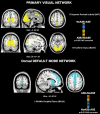Resting-State Networks of Adolescents Experiencing Depersonalization-Like Illusions: Cross-sectional and Longitudinal Findings
- PMID: 29566227
- PMCID: PMC6188529
- DOI: 10.1093/schbul/sby031
Resting-State Networks of Adolescents Experiencing Depersonalization-Like Illusions: Cross-sectional and Longitudinal Findings
Abstract
The mirror-gazing task (MGT) experimentally induces illusions, ranging from simple color changes in the specular image of oneself, to depersonalization-like anomalous self-experiences (ASE) as in experiencing one's specular image as someone else. The objective was to characterize how connectivity in resting-state networks (RSNs) differed in adolescents reporting such depersonalization-like ASEs during the MGT, in a cross-sectional (Y1) and in a longitudinal manner (a year after). 75 adolescents were recruited; for the cross-sectional analysis, participants were split into 2 groups: those who reported depersonalization-like ASEs on the MGT (ASE), and those who did not (NoASE). For the longitudinal analysis, participants were split into 3 groups whether they experienced MGT depersonalization-like ASEs: only at Y1 (Remitters), both times (Persisters), or never (Controls). Participants also filled out self-reports assessing schizotypal personality (Schizotypal Personality Questionnaire [SPQ]), and underwent resting-state functional MRI procedure (rs-fMRI). A group level Independent Component Analysis (ICA) was conducted and voxel-wise inter-group differences within RSNs were examined. The rs-fMRI analysis revealed lower connectivity of specific visual areas within the primary visual network (PVN), and higher connectivity of regions within the Default Mode Network (DMN) when contrasting the ASE and NoASE groups. The areas that were atypically connected within the PVN further presented differential pattern of connectivity in the longitudinal analysis. Atypical connectivity of visual area within the DMN at Y1 was associated with higher scores on the disorganized dimension of schizotypy at the second evaluation. The present study uncovers a subtle signature in the RSNs of non-clinical adolescents who experienced task-induced ASEs.
Figures




Similar articles
-
Strange-face-in-the-mirror illusion and schizotypy during adolescence.Schizophr Bull. 2015 Mar;41 Suppl 2(Suppl 2):S475-82. doi: 10.1093/schbul/sbu196. Schizophr Bull. 2015. PMID: 25810060 Free PMC article.
-
A Developmental Study of Mirror-Gazing-Induced Anomalous Self-Experiences and Self-Reported Schizotypy from 7 to 28 Years of Age.Psychopathology. 2022;55(1):49-61. doi: 10.1159/000520984. Epub 2021 Dec 28. Psychopathology. 2022. PMID: 34963124
-
Cortical plasticity after brachial plexus injury and repair: a resting-state functional MRI study.Neurosurg Focus. 2017 Mar;42(3):E14. doi: 10.3171/2016.12.FOCUS16430. Neurosurg Focus. 2017. PMID: 28245732
-
Adolescent resting state networks and their associations with schizotypal trait expression.Front Syst Neurosci. 2010 Aug 5;4:35. doi: 10.3389/fnsys.2010.00035. eCollection 2010. Front Syst Neurosci. 2010. PMID: 20844603 Free PMC article.
-
Altered attention networks and DMN in refractory epilepsy: A resting-state functional and causal connectivity study.Epilepsy Behav. 2018 Nov;88:81-86. doi: 10.1016/j.yebeh.2018.06.045. Epub 2018 Sep 19. Epilepsy Behav. 2018. PMID: 30243110 Clinical Trial.
Cited by
-
The continuum of attention dysfunction: Evidence from dynamic functional network connectivity analysis in neurotypical adolescents.PLoS One. 2023 Jan 20;18(1):e0279260. doi: 10.1371/journal.pone.0279260. eCollection 2023. PLoS One. 2023. PMID: 36662797 Free PMC article.
-
The role of mentalizing in the relationship between schizotypal personality traits and state signs of psychosis risk captured by cognitive and perceptive basic symptoms.Front Psychiatry. 2023 Sep 21;14:1267656. doi: 10.3389/fpsyt.2023.1267656. eCollection 2023. Front Psychiatry. 2023. PMID: 37810595 Free PMC article.
-
Test-retest reliability of time-varying patterns of brain activity across single band and multiband resting-state functional magnetic resonance imaging in healthy older adults.Front Hum Neurosci. 2022 Nov 10;16:980280. doi: 10.3389/fnhum.2022.980280. eCollection 2022. Front Hum Neurosci. 2022. PMID: 36438643 Free PMC article.
References
-
- Sass LA, Parnas J. Schizophrenia, consciousness, and the self. Schizophr Bull. 2003;29:427–444. - PubMed
-
- Schultze-Lutter F, Ruhrmann S, Fusar-Poli P, Bechdolf A, Schimmelmann BG, Klosterkötter J. Basic symptoms and the prediction of first-episode psychosis. Curr Pharm Des. 2012;18:351–357. - PubMed
-
- Fux L, Walger P, Schimmelmann BG, Schultze-Lutter F. The Schizophrenia Proneness Instrument, Child and Youth version (SPI-CY): practicability and discriminative validity. Schizophr Res. 2013;146:69–78. - PubMed
-
- Parnas J, Møller P, Kircher T et al. . EASE: examination of anomalous self-experience. Psychopathology. 2005;38:236–258. - PubMed
-
- Caputo GB. Strange-face-in-the-mirror illusion. Perception. 2010;39:1007–1008. - PubMed
Publication types
MeSH terms
LinkOut - more resources
Full Text Sources
Other Literature Sources
Research Materials
Miscellaneous

